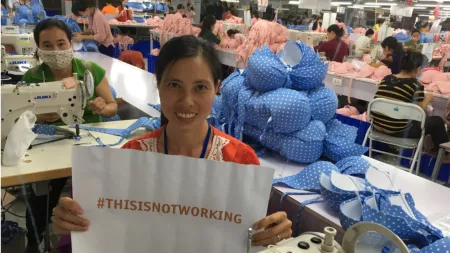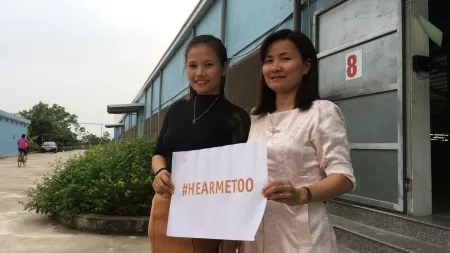How confident are you that you know how to help another person facing sexual harassment? We have mandatory PSHEA trainings, sexual harassment trainings, and trainings about putting gender at the center of all of our work. But when something happens, are you sure you know how to help? For women in garment factories in Vietnam, they are a lot more confident now than they used to be. Now, 89% of women feel that they can help a friend who is being harassed at work. That’s a big deal in a context where people usually don’t talk about sexual harassment at all, and may not believe it’s important.
There's this cultural understanding that sexual harassment is really not much of an issue.. There are some regulations on it, and the Labour Code has some elements that address this, but for lots of people sexual harassment is a bit of a joke...STOP project participant.
How do you turn sexual harassment from a 'joke' to something people take seriously? Offer engaging trainings, advocate for national change, turn policy into practice, and work on supporting not just workers, but also managers, to change the way they approach it.
The STOP project ran from 2017-2020 in 6 factories in Vietnam as part of a regional project funded by the Australian Department of Foreign Affairs and Trade. In Vietnam, the project reached 2,186 people directly and 16,240 people indirectly with $313,984 in funding.
Perhaps even more importantly, what we learned is still shaping what CARE Vietnam does in garment factories today. They still use the same training videos in new factories and provinces. They can see in the original factories the training and communications materials are still up and helping workers decide how to respond, and they are focused on how to do more to get factory management to change their behavior and practices, in addition to worker trainings. (Stay tuned for a lot more learning from a project about to launch that focuses on changing business behaviours).
What changed?
- Workers are more confident they can help each other. Women are more likely to feel confident that they could help a friend being harassed, from 77% to 89%.
- Workers understand their rights, and what behavior they have a right to see stop. Worker awareness of what constitutes sexual harassment went up, from 52% at baseline to 80% at endline. Awareness makes a big difference. In the words of one partner: “I think that for many of the women having that understanding that this is something they should not accept was a very big step forward for actually here in Vietnam and the same for men where suddenly they were confronted with... ‘actually this is something you should not do and this has effect on the person you're harassing’.
- Managers are more ready to deal with harassment. Managers understand sexual harassment better from 67% in 2017 to 86% in 2020.
- Women think reporting matters more. Women are more likely to think reporting sexual harassment is important, from 67% at baseline to 82% at endline.

How did it happen?
- Put policies into practice. STOP supported factories to not just adopt, but also to roll-out Workplace Sexual Harassment Prevention policies and guidelines. The team did reviews on paper, and focused on implementing the new labor codes, including policy consultations and legal consultants with 6 factories to adopt the new legal codes. It changed the way people were thinking about advocacy: “Now, actually, at this moment, we are looking at implementation, to provide detailed implementation guidelines for the new labour court on gender equality promotion to female workers.” (BNV, MOLISA)
- Consider the local context. Because people started from the premise that sexual harassment is just jokes, the team adapted a lot of tools to fit the context better. They had animated videos, games, and communications materials that started from the local context and what would make sense here. They built tools they still use that get people to accept a new idea and change the way they approach the problem.
- Get managers involved. Training managers and employees on sexual harassment was a core project component.
- Learn and adapt, by helping factories set up a monitoring and learning framework.
- Change the legal environment. The team advocated for the national government to adopt the new national labor code with better protections around sexual harassment.
- Partner with others. CARE Vietnam built partnerships across a range of stakeholders, from factories to governments to civil society like the Gender based Violence Network. One stakeholder says, “We can see that CARE is working closely in all our project activities and CARE understanding thoroughly about what we are doing with partners; when they see something good or interesting and they will share with other stakeholders.” (CDI – collected for MTR)
- Hire experts, and focus for the long run. In the words of one organization about CARE’s team, “They are obviously experts in the field or at least that’s what we feel. They’ve been doing this sort of work for a long time.”
Want to learn more?
Check out the evaluation, look at the regional impacts, or watch the animated videos on sexual harassment training. Really, check out all of CARE Vietnam’s videos. They do a lot of wonderful ones.
